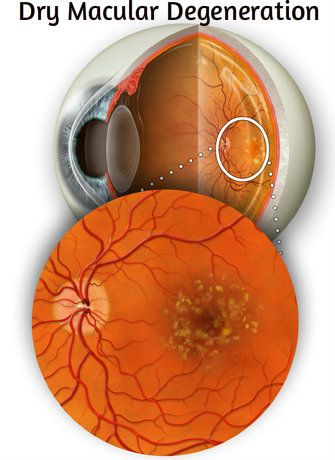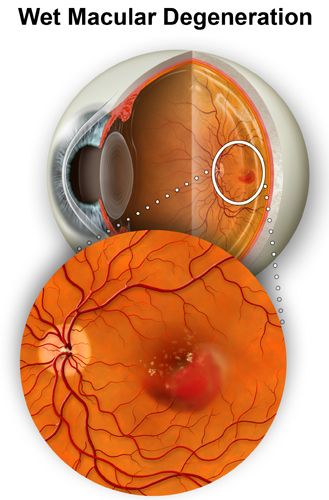You are here
Age-Related Macular Degeneration
What is Age-Related Macular Degeneration?
Macular degeneration is the leading cause of severe vision loss in people over age 60. It occurs when the small central portion of the retina, known as the macula, deteriorates. The retina is the light-sensing nerve tissue at the back of the eye. Because the disease develops as a person ages, it is often referred to as age-related macular degeneration (AMD). Although macular degeneration is almost never a totally blinding condition, it can be a source of significant visual disability.
There are two main types of age-related macular degeneration:
- Dry Form - The "dry" form of macular degeneration is characterized by the presence of yellow deposits, called drusen, in the macula. A few small drusen may not cause changes in vision; however, as they grow in size and increase in number, they may lead to a dimming or distortion of vision that people find most noticeable when they read. In more advanced stages of dry macular degeneration, there is also a thinning of the light-sensitive layer of cells in the macula leading to atrophy, or tissue death. In the atrophic form of dry macular degeneration, patients may have blind spots in the center of their vision. In the advanced stages, patients lose central vision.
- Wet Form - The "wet" form of macular degeneration is characterized by the growth of abnormal blood vessels from the choroid underneath the macula. This is called choroidal neovascularization. These blood vessels leak blood and fluid into the retina, causing distortion of vision that makes straight lines look wavy, as well as blind spots and loss of central vision. These abnormal blood vessels eventually scar, leading to permanent loss of central vision.
- Age - Your risk of macular degeneration increases as you age, it is most common in people over age 60.
- Family history - Your odds of developing macular degeneration are higher if you have a family history of the disease.
- Race - Macular degeneration is more common in whites than it is in other races, especially after age 75.
- Gender - Women are more likely than are men to develop macular degeneration.
- Smoking - Smoking cigarettes increases your risk of macular degeneration.
- Diet - A diet that includes few fruits and vegetables may increase the risk of macular degeneration.
- High blood pressure - Diseases that affect the circulatory system, such as high blood pressure, may increase the risk of macular degeneration.
- High cholesterol - An elevated cholesterol level in your blood is associated with an increased risk of macular degeneration
- Straight lines appear wavy
- The center of vision appears distorted but the other areas of vision remain clear
- The center of vision appears dark, white or blurry
- The ability to perceive colors changes or diminishes
- Dilated Eye Exam and Visual Acuity Test -
- Amsler Grid -
- OCT -
- Eye Angiogram -

Most patients with macular degeneration have the dry form of the disease and will not lose central vision. However, the dry form of macular degeneration can lead to the wet form. Although only about 10% of people with macular degeneration develop the wet form, they make up the majority of those who experience serious vision loss from the disease.
It is very important for people with macular degeneration to monitor their eyesight carefully and see their eye doctor on a regular basis.
Are You at Risk for Macular Degeneration?
Factors that may increase your risk of macular degeneration include:
What are the Symptoms of Macular Degeneration?
.jpg)
There are signs that the disease is present in the eye. If you are experiencing any of the following symptoms you should see an ophthalmologist immediately:
.jpg)
A qualified ophthalmologist can detect signs of macular degeneration during a routine eye examination. Declining vision or a change in the eye’s blood vessels are often indications that macular degeneration is occurring.
How is Macular Degeneration Diagnosed?
A qualified ophthalmologist can detect signs of macular degeneration during a routine eye examination. Declining vision or a change in the eye’s blood vessels are often indications that macular degeneration is occurring. You will Some of the tests done to detect macular degeneration may include:
How is Macular Degeneration Treated?
Home
......................................
Locations
......................................
Schedule Appointment
About
......................................
Press & Events
......................................
Testimonials
Retina Conditions
......................................
AMD - Macular Degeneration
......................................
Diabetic Eye Disease
......................................
Epiretinal Membrane
......................................
Macular Hole
......................................
Retinal Detachment
Research
......................................
Tools & Resources
......................................
Contact



